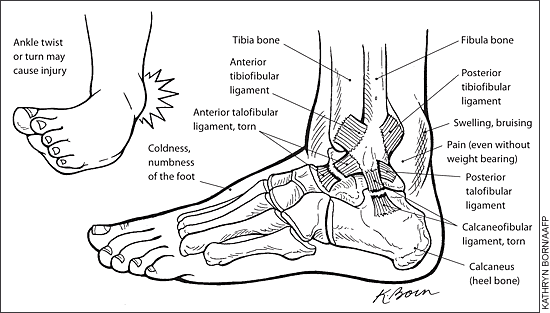
Am Fam Physician. 2006;74(10):1723-1724
See related article on ankle sprains.
What is an ankle sprain?
Ligaments connect bones in your ankle. If you turn or twist your ankle in an unusual way, the ligaments can stretch or tear. This is called an ankle sprain (see drawing).

How can I tell if I have an ankle sprain?
If it is sprained, your ankle may hurt even if you aren't standing on it. Your ankle may be swollen or bruised and you may not be able to move it very well.
You should go to the doctor if your ankle hurts badly, if you can't walk or stand on your ankle, or if your foot is cold or numb. You also should go to the doctor if you have diabetes or another serious illness and you think you have an ankle injury, even if you aren't sure how badly it's hurt.
How is an ankle sprain treated?
Ibuprofen (one brand: Motrin) or naproxen (one brand: Aleve) can help with the pain. Putting ice on your ankle and wrapping it with a bandage can help keep your ankle from swelling and bruising. Keeping your ankle raised also can help. You should not walk on your ankle until your doctor says it's okay.
Two or three days after your injury, you should start exercising your ankle several times a day to make it stronger. Ask your doctor when it's okay for you to exercise.
How can I prevent an ankle sprain?
Wear shoes that fit. Stretch before and after activity. If you have had a sprain before, ask your doctor what you can wear to help support your ankle when you are very active. Talk to your doctor about how to prevent an ankle injury while playing sports.
Where can I get more information?
Your doctor
American Academy of Orthopaedic Surgeons
Web site:http://orthoinfo.aaos.org/all.cfm#foot (click on “sprained ankle”)